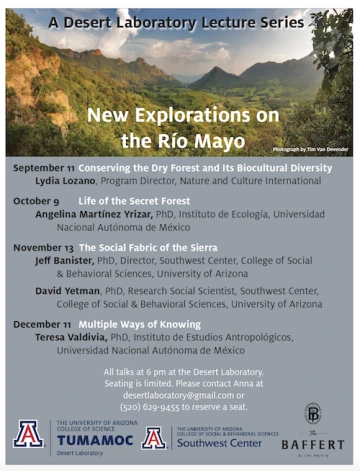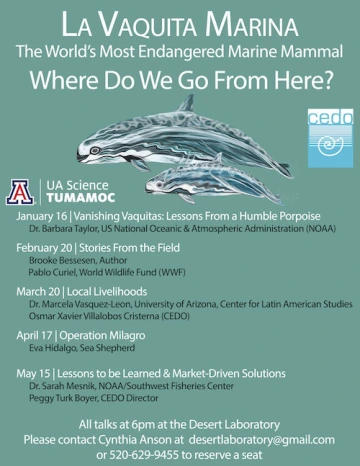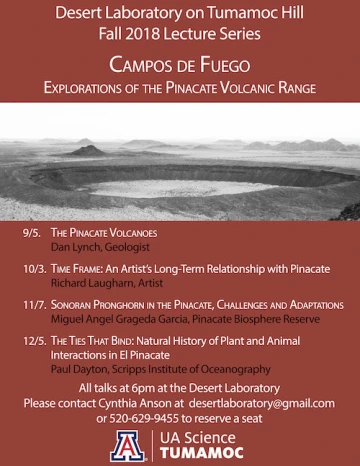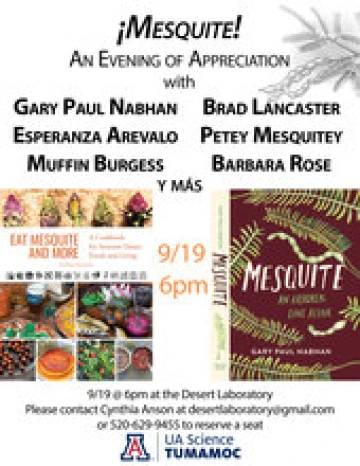Fall 2019 Lecture Series
New Explorations on the Río Mayo
In Collaboration with The Southwest Center

Did you know that the Sonoran Desert originated in part from the tropics? The Río Mayo drainage of the Sierra Madre mountains near Álamos, Sonora, Mexico, is a convergence zone of astonishing biological and cultural diversity. Research into this unique and imperiled ecosystem at the Desert Laboratory on Tumamoc Hill extends back to the 1940s. Please join the Desert Laboratory and The Southwest Center for this series as we venture back to the Río Mayo and hear from a diversity of researchers and community members who will highlight new explorations, biocultural understandings, and efforts to preserve the tropics next door.
Videos of Lectures in This Series
Spring 2019 Lecture Series
La Vaquita Marina: Where do we go from here?
In Collaboration with CEDO, Intercultural Center for the Study of Deserts and Oceans celebrating their 40th anniversary

La Vaquita Marina, a small porpoise endemic to the upper Gulf of California, is on the precipice of extinction. Global scale economic pressure fuels local gill-net fishing that ensnare the vaquita, driving their numbers down to as few as a dozen individuals remaining. This lecture series with experts from Mexico and the United States will explore what lessons we can learn from an intertwined web of science, local and global economics, politics, black markets, and conservation. What can be taken from this dire situation for future conservation? Where does the middle ground exist and how do we get there?
Videos of Lectures in This Series
1) Vanishing Vaquitas Dr. Barbara Taylor
2) Stories from the Field Brooke Bessesen
3) Local Livelihoods Dr. Marcela Vasquez Leon | Osmar Xavier Villalobos Cristerna
4) Operation Milagro Eva Hidalgo, Panopto
Fall 2018 Lecture Schedule
Campos de Fuego: Explorations of the Pinacate

Since the Hornaday expedition set off from the Desert Laboratory in 1907, captured in the book Camp fires on Desert and Lava, there has been a unique connection between Tumamoc Hill and this enigmatic volcanic range in NW Mexico. Recognized by many as the desert’s heart, the Pinacate has captivated and inspired those who have traversed its rugged slopes, peaks, and dunes. Please join four of those individuals as they connect you to this special region of our desert and in celebration of the first bilingual publication of the 1928 novel Campos de Fuego: A Brief and Fantastic History of an Expedition into the Volcanic Regions of the Pinacate by Gumersindo Esquer, Contribution 2 of the Proceedings of the Desert Laboratory.
Videos of Lectures in This Series
- 9/5/2018, Dan Lynch – The Pinacate Volcanoes
- 10/3/2018, Richard Laugharn – Time Frame: An Artist’s Long-Term Relationship with Pinacate
- 11/7/2018, Miguel Grageda – Sonoran Pronghorn in the Pinacate Biosphere Reserve, a Story of Challenges and Adaptations
- 12/5/2018, Paul Dayton – The Ties That Bind: Natural History of Plant and Animal Interactions in El Pinacate
***Mesquite: An Evening of Appreciation***September 19, 2018 6:00 pm

Gary Paul Nabhan, Brad Lancaster, Esperanza Arevalo, Petey Mesquitey, Muffin Burgess, Barbara Rose, and more!
Join an amazing group of people at the center of the Mesquite and native foods revolution. The evening will honor and look into the future of the local food movement with Gary Nabhan, Desert Harvesters, Muffin Burgess, and more!
Winter/Spring 2018 Lecture Schedule
Tuesday, February 13, 6:00 p.m.
Oasis: Biodiversity Gems in the Southern Sonoran Desert
Presenter: Michael Bogan, Assistant Professor, School of Natural Resources and the Environment
In the arid southern Sonoran Desert, the rugged canyons of the Sierra El Aguaje contain a surprising number of freshwater oases fed by groundwater that rises through geologic faults. At least 220 species of aquatic animals, including six undescribed species, have been documented from the oases in recent years. Genetic evidence from fish and frogs suggests that these or similar spring-fed habitats have persisted in the mountain range for thousands to millions of years. Groundwater pumping, the introduction of non-native species, and unmanaged human recreation all pose threats to the biodiversity of these unique desert oases.
***Thursday, March 8th, 6:00 p.m.***
Border | Boundary | Frontier
Readings by Francisco Cantú and David Taylor
As a prelude to the Tucson Festival of Books, join authors Francisco Cantú and David Taylor for a special evening of readings and visual presentations that will yield insights into the complexity of the borderlands.

